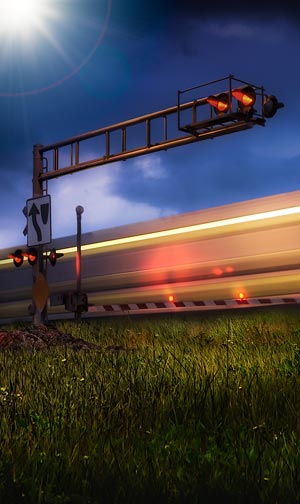
MARC Train Accident Lawyer
Although trains are convenient for commuting and transporting merchandise, they’ve become more dangerous over time, because of increased speeds. Very few train riders died in a single United States train crash up until 1853. That is because early trains ran at slow speeds and made short trips, and night travel was a rarity. Additionally, trains were fewer in number back then.
With increased speeds, train collisions occur more frequently in the modern era. The National Transportation Safety Bureau estimates that about 1,000 people lose their lives in train-related accidents each year.
The Maryland Area Regional Commuter (MARC) train is one of the quickest and busiest commuter rail systems in the country. Like many other railway systems in the United States, the MARC has its fair share of collisions.
People involved in a MARC train accident can sustain devastating injuries, like brain injury, broken bones, burns, crushed lungs and paralysis. Many times, the accidents are preventable. Investigators have regularly discovered that negligence has contributed to derailment, collisions, or other types of train crashes.
The MARC train system has three lines operating in the Baltimore-Washington metropolitan area, i.e., Camden, Penn and Brunswick. MARC currently operates 94 trains during the week, which can travel at a top speed of 125mph.
MARC Train Accident and Human Error
Several accidents have happened since MARC came into existence in the 1830s. One example is the 1996 collision that involved the Brunswick Line and an Amtrak Train. It killed 11 passengers aboard the MARC train. Official investigations suggested that the accident might have been avoided if a human error analysis had been performed.
Another accident in 2008 happened when an Amtrak switcher train hit and derailed a MARC train in Union Station. It’s believed that Amtrak was traveling too quickly before the crash occurred. Luckily, there were only seven people who sustained minor injuries.
Recently in 2019, a teenage boy suffered critical injuries after he was hit by a MARC train while crossing the tracks. The accident led to the suspension of the MARC’s Camden Line.
Factors That Can Contribute to a Train Crash
Some of the issues that can contribute to a MARC train accident include:
- Faulty computer systems
- Improperly maintained rail tracks that cause trains to go off course
- Distracted train operators or conductors who are texting, making cell phone calls, or chatting with coworkers
- Outdated equipment or train parts
- Poor train signals that put two trains on a crash course with each other
Negligence and MARC Train Accidents
When it comes to train accidents, negligence can play a role. The negligence can be on the part of the train personnel. It might be negligence in failing to ensure the computer systems are functioning well. Additionally, negligence can involve poorly maintained equipment or failure to resolve potential safety and maintenance problems.
Contact an Experienced Train Accident Attorney
If you or someone you know has been seriously injured in a MARC train accident, a lawyer can guard your rights. They can investigate the cause of the accident to help you determine what led to the incident. If negligence was a contributing factor, you might have a right to pursue compensation to cover medical bills, and other damages. Contact the experienced personal injury lawyers of Pottroff & Karlin, LLC Law Firm, for a free, no-commitment consultation.

Railroad News
Testimonials
Train crash cases are unique and complex with many different potential pitfalls, such as federal preemption. Anytime I get hired or even get a call from a train crash victim, my very first call is to Nathan’s firm. Nathan’s knowledge and experience in handling and trying cases against these litigation savvy railroad companies gives me the confidence to know that the clients and cases I refer to him are getting the best of the best.
James Perrin Lubbock, Texas
I have had the opportunity to work as co-counsel with Nathan on several railroad crossing accidents cases. In each case, Nathan always possessed an incredible knowledge of the law and the facts, possessed a great talent for aggressive - strategic legal planning and trial tactics while, at the same time, displaying great skill as an effective negotiator. I would recommend him to anyone without hesitation.
Scott McCluen Harriman, Tennessee
Nathan Karlin has my strongest endorsement in the field of railroad crossing cases and personal injury law. I had the pleasure of working with Nathan in a complex railroad personal injury case. I was impressed by Nathan’s knowledge, his work ethic, and his dedication to the client. I look forward to working with Nathan on future injury matters. I am also aware firsthand that he has obtained excellent trial and settlement results in numerous cases involving members of the public harmed by railroad companies.
Joseph M. Miller Mandeville, Louisiana
Nathan is a warrior fighting the railroads. As a fellow personal injury lawyer, I have constantly been impressed with his depth of knowledge and his capabilities from case to case. I’d take him into battle with me any day against the biggest railroads and insurance companies on the planet.
Jon C. Clark Austin, Texas
Bob Pottroff has fought for the victims of the railroads’ callous disregard for safety more than any other attorney that I know. I should know because I am currently Chair-elect of the Railroad Section of ATLA.
Robert Schuetze Boulder, Colorado
Mr. Pottroff has shaken the rail industry to its very roots. Settlements are now more common as a result of the way he has exposed the industry’s wrongdoing.
Mike Easley Arkansas
Bob Pottroff’s work in railroad safety law is unmatched and he has been the source of great advice and phenomenal creativity.
Roger Brown Jefferson City, Missouri
In addition to his substantive contributions to railroad grade crossing safety, I have personally observed his untiring efforts and contributions to improving the integrity of the legal system.
Elizabeth Hardy Lake Charles, Louisiana
- 1
- 2
- 3
- 4
- 5
- 6
- 7
- 8
